Research by Scott M. Graffius Featured in Scientific Paper Published by INFORMS
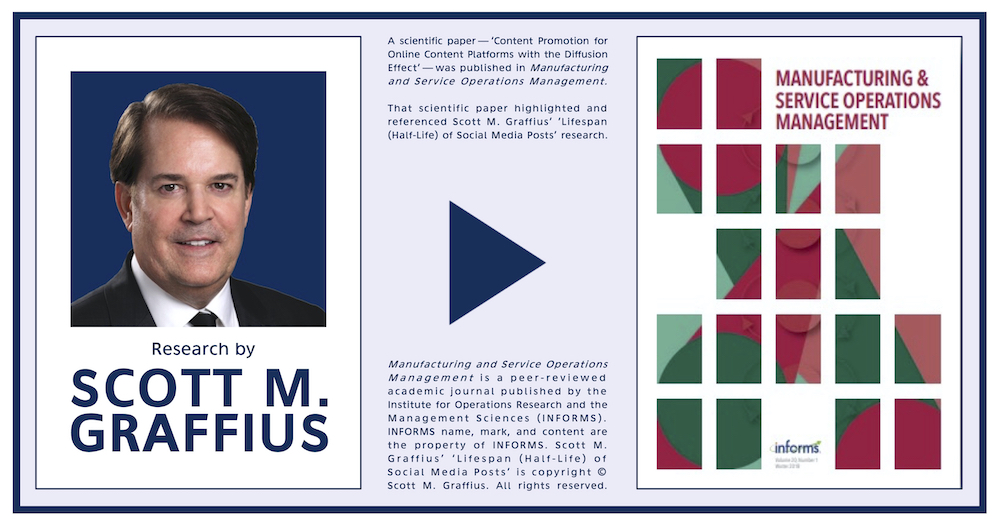

When content is published online, relevance and engagement have a limited lifespan. An advantageous objective metric is half-life. It’s the time it takes for a post to receive half of its total engagement (such as likes, shares, and comments). Data can help inform strategic and tactical decisions, such as the frequency and scheduling of posts.
However, reports by others on the shelf life of social media are often outdated or based on the experience of one person, one organization, or one limited set of data. With any of those common limitations, findings are at risk of being non-representative, inaccurate, or unreliable.
It’s important to have a large dataset from multiple sources. In addition to generating results that are more likely to be appropriately representative, accurate, and reliable, this approach provides a more complete picture and helps identify trends.
In 2018, Scott M. Graffius first published data on the average lifespan (half-life) of posts on Snapchat, X (formerly Twitter), Facebook, Instagram, LinkedIn, YouTube, Pinterest, and blogs — based on data from multiple sources. Algorithms and other factors on platforms change over time. For that reason, Graffius periodically updates the analysis. The current (2024) edition of his ‘Lifespan (Half-Life) of Social Media Posts’ is here.
Scientists, researchers, journalists, academics, YouTubers, podcasters, SEO experts, analysts, businesses, and others have featured and used Graffius’ research.
Manufacturing and Service Operations Management, a publication of the Institute for Operations Research and the Management Sciences (INFORMS), was added to the list.
A scientific paper — ‘Content Promotion for Online Content Platforms with the Diffusion Effect’ — was published in Manufacturing and Service Operations Management. That scientific paper highlighted and referenced Scott M. Graffius’ ‘Lifespan (Half-Life) of Social Media Posts’ research.
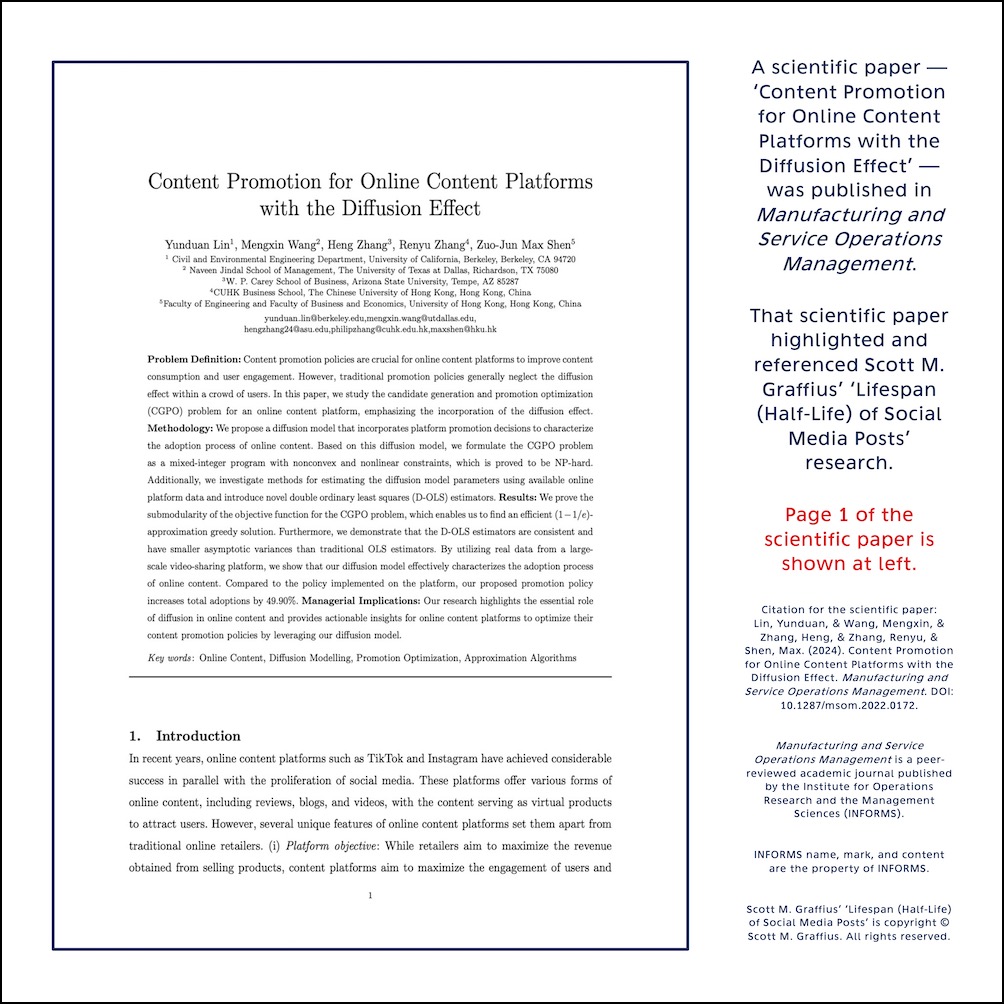
Page 1 of the scientific paper is shown at above.
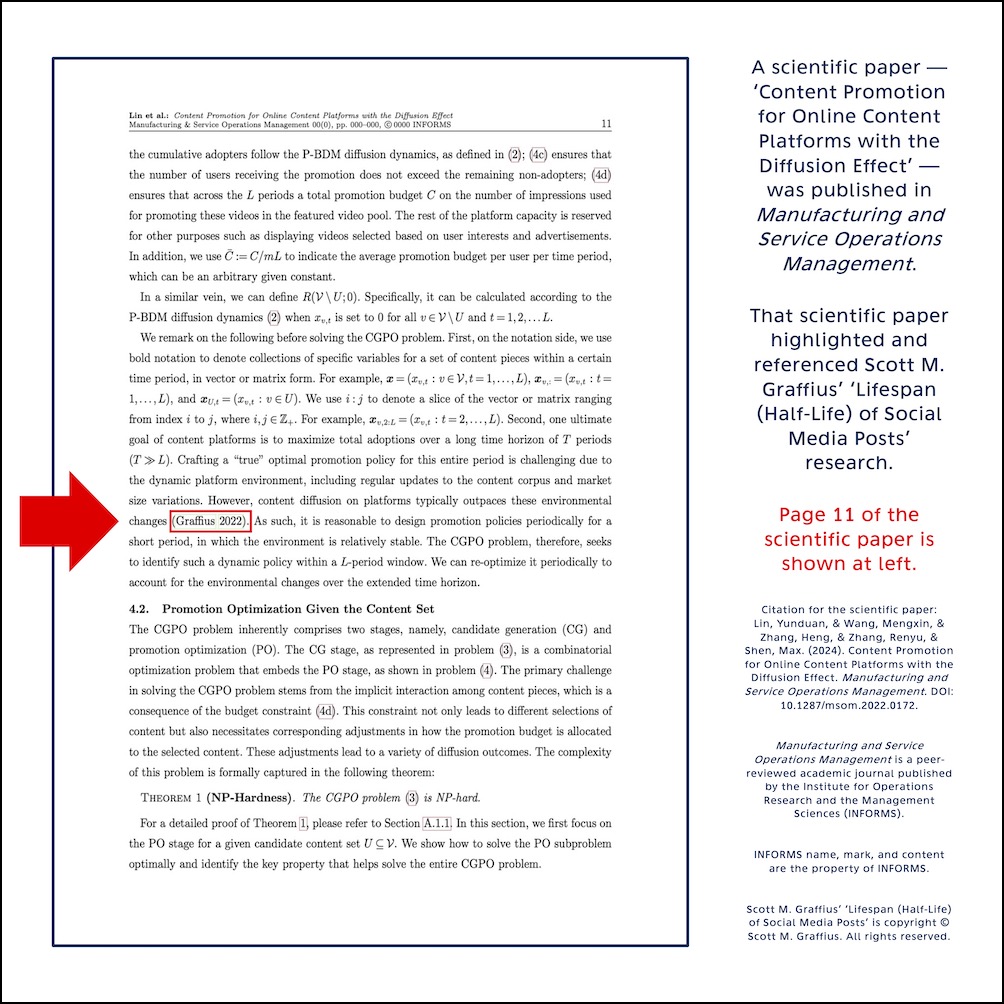
Page 11 of the scientific paper is shown at above.
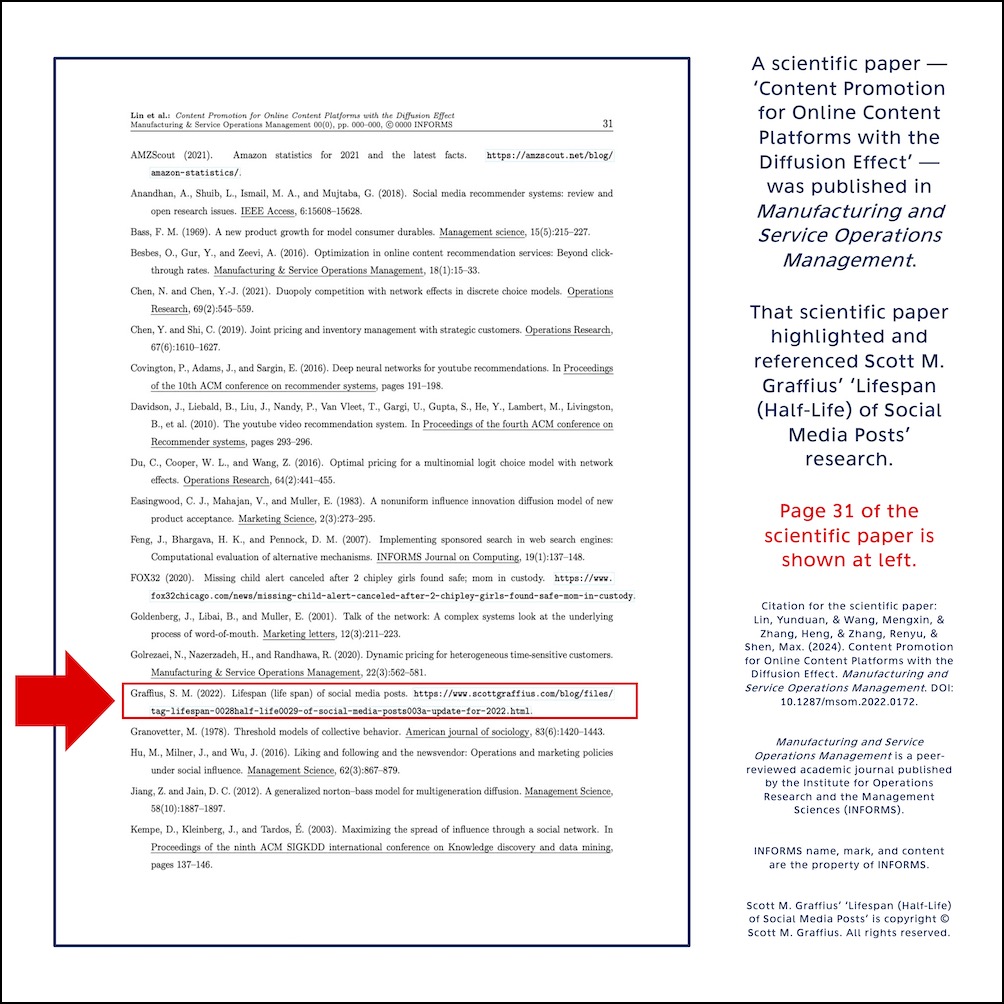
Page 31 of the scientific paper is shown at above.
Citation for the scientific paper:
Lin, Yunduan, & Wang, Mengxin, & Zhang, Heng, & Zhang, Renyu, & Shen, Max. (2024, March). Content Promotion for Online Content Platforms with the Diffusion Effect. Manufacturing and Service Operations Management. DOI: 10.1287/msom.2022.0172.
About Manufacturing and Service Operations Management
Manufacturing and Service Operations Management (M&SOM) is a bi-monthly peer-reviewed academic journal established in 1999 that is published by the Institute for Operations Research and the Management Sciences (INFORMS). M&SOM presents state-of-the-art research of interest to both academic and industry researchers and practitioners working at the interface of research and implementation. Visit https://pubsonline.informs.org/journal/msom to learn more.
Institute for Operations Research and the Management Sciences
With almost 12,000 members worldwide, the Institute for Operations Research and the Management Sciences (INFORMS) is the leading international association for professionals in operations research, analytics, management science, economics, behavioral science, statistics, artificial intelligence, data science, applied mathematics, and related fields.
INFORMS advances and promotes the science and technology of decision making to save lives, save money, and solve problems through an array of highly-cited publications, conferences, competitions, networking communities, and professional development services. Its slogan is “Smarter Decisions for a Better World.” To learn more, visit https://www.informs.org.




About Scott M. Graffius

Scott M. Graffius, PMP, SA, CSP-SM, CSP-PO, CSM, CSPO, ITIL, LSSGB is an agile project management practitioner, consultant, thinker, creator, multi-award-winning author, and international public speaker. Founder and CEO of Exceptional PPM and PMO Solutions™ and subsidiary Exceptional Agility™, he has generated over $1.9 billion for Global Fortune 500 businesses and other organizations he has served. Graffius and content from his books, talks, workshops, and more have been featured and used by Microsoft, Oracle, Broadcom, Cisco, Gartner, Project Management Institute, IEEE, National Academy of Sciences, United States Department of Energy, Yale University, Tufts University, and others. He delights audiences with dynamic and engaging talks and workshops on agile project management, AI, Tech leadership, video game development, strategic alignment, the science of high performance teams, and more. To date, he's presented sessions at 89 conferences and other events across 25 countries.
His full bio is available here.
Connect with Scott on:

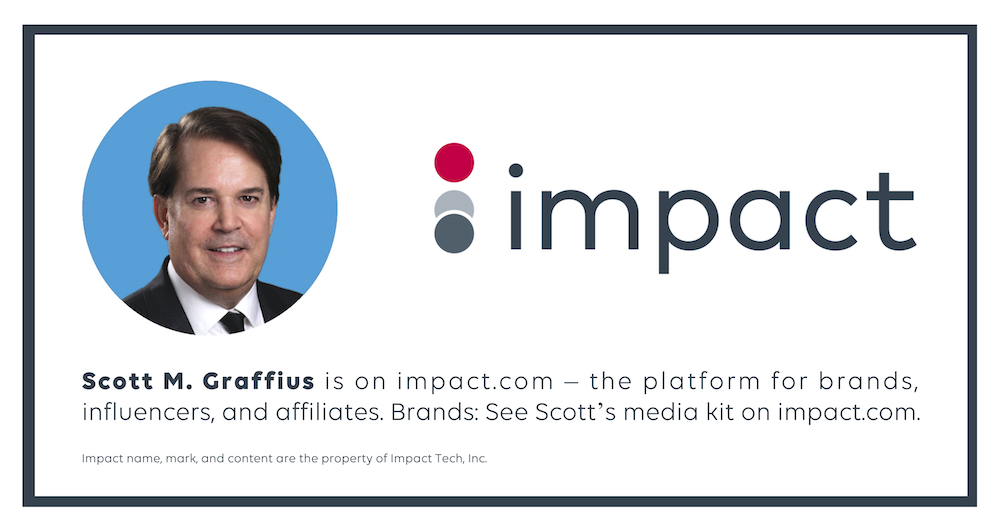

About Agile Scrum: Your Quick Start Guide with Step-by-Step Instructions

Shifting customer needs are common in today's marketplace. Businesses must be adaptive and responsive to change while delivering an exceptional customer experience to be competitive.
There are a variety of frameworks supporting the development of products and services, and most approaches fall into one of two broad categories: traditional or agile. Traditional practices such as waterfall engage sequential development, while agile involves iterative and incremental deliverables. Organizations are increasingly embracing agile to manage projects, and best meet their business needs of rapid response to change, fast delivery speed, and more.
With clear and easy to follow step-by-step instructions, Scott M. Graffius's award-winning Agile Scrum: Your Quick Start Guide with Step-by-Step Instructions helps the reader:
- Implement and use the most popular agile framework―Scrum;
- Deliver products in short cycles with rapid adaptation to change, fast time-to-market, and continuous improvement; and
- Support innovation and drive competitive advantage.
Hailed by Literary Titan as “the book highlights the versatility of Scrum beautifully.”
Winner of 17 first place awards.
Agile Scrum: Your Quick Start Guide with Step-by-Step Instructions is available in paperback and ebook/Kindle in the United States and around the world. Some links by country follow.
- 🇧🇷 Brazil
- 🇨🇦 Canada
- 🇨🇿 Czech Republic
- 🇩🇰 Denmark
- 🇫🇮 Finland
- 🇫🇷 France
- 🇩🇪 Germany
- 🇬🇷 Greece
- 🇭🇺 Hungary
- 🇮🇳 India
- 🇮🇪 Ireland
- 🇮🇱 Israel
- 🇮🇹 Italy
- 🇯🇵 Japan
- 🇱🇺 Luxembourg
- 🇲🇽 Mexico
- 🇳🇱 Netherlands
- 🇳🇿 New Zealand
- 🇳🇴 Norway
- 🇪🇸 Spain
- 🇸🇪 Sweden
- 🇨🇭 Switzerland
- 🇦🇪 UAE
- 🇬🇧 United Kingdom
- 🇺🇸 United States

About Agile Transformation: A Brief Story of How an Entertainment Company Developed New Capabilities and Unlocked Business Agility to Thrive in an Era of Rapid Change
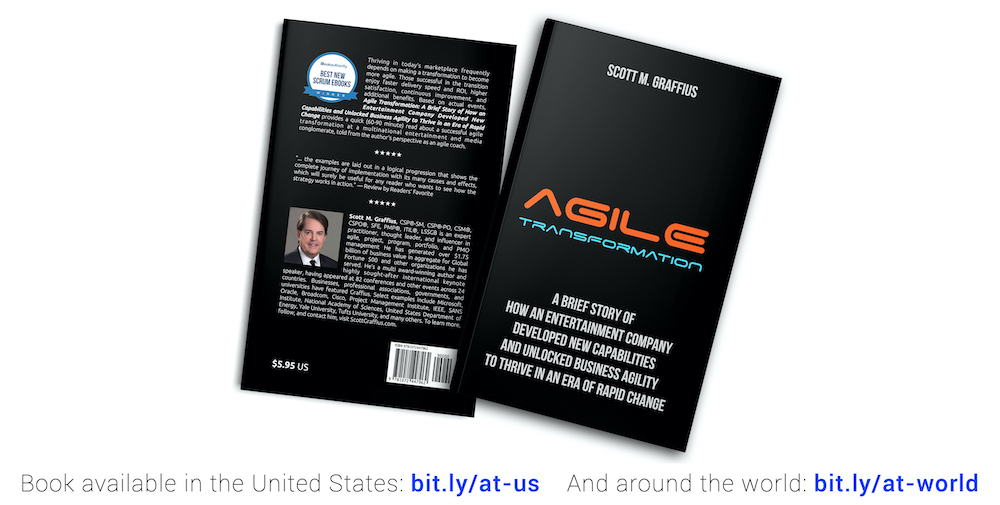
Thriving in today's marketplace frequently depends on making a transformation to become more agile. Those successful in the transition enjoy faster delivery speed and ROI, higher satisfaction, continuous improvement, and additional benefits.
Based on actual events, Agile Transformation: A Brief Story of How an Entertainment Company Developed New Capabilities and Unlocked Business Agility to Thrive in an Era of Rapid Change provides a quick (60-90 minute) read about a successful agile transformation at a multinational entertainment and media company, told from the author's perspective as an agile coach.
The award-winning book by Scott M. Graffius is available in paperback and ebook/Kindle in the United States and around the world. Some links by country follow.
- 🇦🇺 Australia
- 🇦🇹 Austria
- 🇧🇷 Brazil
- 🇨🇦 Canada
- 🇨🇿 Czech Republic
- 🇩🇰 Denmark
- 🇫🇮 Finland
- 🇫🇷 France
- 🇩🇪 Germany
- 🇬🇷 Greece
- 🇮🇳 India
- 🇮🇪 Ireland
- 🇯🇵 Japan
- 🇱🇺 Luxembourg
- 🇲🇽 Mexico
- 🇳🇱 Netherlands
- 🇳🇿 New Zealand
- 🇪🇸 Spain
- 🇸🇪 Sweden
- 🇨🇭 Switzerland
- 🇦🇪 United Arab Emirates
- 🇬🇧 United Kingdom
- 🇺🇸 United States

The short link for this article is: https://bit.ly/infrm-24
© Copyright 2024 Scott M. Graffius. All rights reserved. This material may not be published, broadcast, rewritten or redistributed without the express written permission of Scott M. Graffius.

Reporting Errors in a Publication: A Case Study on ‘Frontiers in Public Health’

Any updates after this article is published will appear in the Post-Publication Notes section at the end of the article.

Introduction
Errors in published works can unleash a cascade of profound effects: they corrupt the well of knowledge, deceive those seeking truth, and shatter the foundation of credibility. As explored in the widely read article on reporting errors, taking action to address such issues plays a pivotal role in ensuring the accuracy and integrity of knowledge.
But what happens when errors go unaddressed, even after being reported with detailed evidence? This article presents a case study from Graffius’ own experience, where a publication in Frontiers in Public Health mischaracterized his research on the lifespan (half-life) of social media posts (2024 edition) and incorrectly cited his work. Despite reporting these issues to the lead author and publisher, the response—or lack thereof in this case—reveals the challenges and persistence required to uphold research integrity. Through this case study, this article illustrates the error reporting process, the importance of follow-through, and the lessons learned.
Graffius' 'Lifespan (Half-Life) of Social Media Posts' Research
When content is published on social media platforms, relevance and engagement have a limited lifespan. Most posts receive half of their total engagement (such as likes, shares, and comments) relatively soon, with the remainder spread out over a comparatively longer period. Said differently, plotting engagement against time typically reveals a distribution where the peak engagement occurs early, with a long tail of diminishing interaction, resembling a positively skewed unimodal distribution.
Given the above, an advantageous, objective metric for social media posts is half-life. It’s the time it takes for a post to receive half of its total engagement. Data can help inform strategic and tactical decisions, such as the frequency and scheduling of posts.
In 2018, Scott M. Graffius first published data on the average half-life of posts based on a large dataset comprised of multiple sources. Algorithms and other factors on platforms change over time. For that reason, Graffius periodically updates his 'Lifespan (Half-Life) of Social Media Posts' research. His work has captured the attention of, and is used by, a diverse global audience of businesses, professional associations, government agencies, universities, and others.
Errors in Frontiers in Public Health
A paper published in Frontiers in Public Health, titled 'Public perceptions of digital mental health awareness campaign in the Arab Gulf states: a qualitative thematic analysis,' inaccurately portrayed findings from the 'Lifespan (Half-Life) of Social Media Posts' research. The Frontiers authors wrongly claimed that, "the lifespan of social media posts on most platforms is, at most, 9 days," conflating 'lifespan' with 'half-life.' Their error misrepresented the research’s conclusions. Furthermore, the Frontiers paper mis-referenced Graffius’ work, citing an incorrect title and omitting the DOI, undermining the accuracy of the scholarship.
Limited excerpts from the problematic Frontiers in Public Health paper follow.

Due to its errors, the Frontiers paper misleads readers, posing a risk of misinformation that could negatively impact future research or the improper application of its findings.
Action Taken: Reporting and Following Up on the Errors
Following Graffius' own recommendation on what to do when discovering errors (available at https://scottgraffius.com/blog/files/error-reporting.html), he took action. On 18 December 2024, Graffius sent an email to the lead author, Noura Alomair, and included the editorial and publishing team at Frontiers in Public Health. The email delineated the factual error and the citation error, and it provided specific corrections for both. Excerpts from Graffius' email are shown in blue font.
1. Factual error.
The data collection section on page 03 includes this: "The lifespan of social media posts on most platforms is, at most, 9 days (19)."
However, the metric is half-life. I defined it in my research (which you cited): "The lifespan of posts is of interest, and a helpful metric is half-life. It’s the amount of time it takes for a post to receive half of its total engagement (such as likes, shares, and comments)."
Additional information — for background and context only:
- When content is published online, relevance and engagement have a limited lifespan. Engagement is typically not distributed as a normal bell curve. Rather, it’s generally a unimodal distribution-based, positively skewed curve.
- Here’s a description of the prototypical distribution of data (engagement): On average, most posts receive half of their total engagement relatively soon, with the remainder spread out over a comparatively long(er) period.
- For those reasons, an advantageous respective objective metric for posts on social media platforms is half-life. It’s the time it takes for a post to receive half of its total engagement (such as likes, shares, and comments).
- Built on a large dataset from multiple sources, Graffius’ research reveals the average lifespan (half-life) for posts on different social media platforms.
- Note: Findings from others — including anecdotal experience from select posts or otherwise the experience of one person, one organization, or a limited dataset — may vary from the average half-life data in Graffius’ research.
Accordingly, I suggest that this:
"The lifespan of social media posts on most platforms is, at most, 9 days (19)."
is corrected to this (or similar):
"Posts on top social media platforms typically receive half of their total engagement (such as likes, shares, and comments) quickly, ranging from seconds to under nine days. After that half-life point, posts start to get buried in the news feed."
2. Citation error.
Except for my work, items in the references section reflect the following template/example: "Braun V, Clarke V. Reflecting on reflexive thematic analysis. Qual Res Sport, Exerc Health. (2019) 11:589– 97. doi: 10.1080/2159676X.2019.1628806". The reference for my work is shown as: "GRAFFIUS SM. Half-life for posts on different social media platforms. (2024)." My last name is in all caps, which is not consistent with other entries. Additionally, the title is wrong, and the DOI (or, alternatively, link) is missing.
I suggest that it is corrected to this:
"Graffius SM. Lifespan (half-life) of social media posts: update for 2024. (2024). doi: 10.13140/RG.2.2.21043.60965."
Except for an auto-reply from the publisher—which promised communication "within 5 business days"—there was no response to Graffius' report of the errors. As of 20 March 2025 (the date of this article), there have been 92 days of radio silence. That's deeply concerning.
Consistent with the persistence advocated for in Graffius' own error-reporting guide, he sent a follow-up email on 20 March 2025, reiterating the errors and emphasizing the importance of research integrity. He wrote, "I imagine that, like me, you value the integrity of the academic record and would want to correct these errors to ensure the accuracy and reliability of the published work." This case study—inclusive of finding and reporting errors, getting radio silence, and more—underscores challenges of ensuring accountability in publishing.
Conclusion
As demonstrated by their action or inaction, some authors, editors, and publishers appreciate finding out about errors so that they can correct them, while others do not. The error reporting experience with Frontiers in Public Health was frustrating due to inaction from both the lead author and the publishing team. Despite providing detailed evidence and following up after 92 days of silence, Graffius has yet to receive a response. This case underscores the persistence sometimes required to uphold integrity. It also highlights the importance of taking action: while the ideal response to an error report is prompt acknowledgment and correction, the reality can be radio silence—necessitating further effort.
Whether it's enhancing the experience for future readers or upholding the accuracy and integrity of scientific works, vigilance in reporting errors plays a pivotal role.
If there is an update on this case, it will appear in the Post-Publication Notes section which appears at the end of the article.
Read on for:
- About Frontiers in Public Health,
- About Graffius' 'Lifespan (Half-Life) of Social Media Posts' Research,
- About Scott M. Graffius,
- How to Cite This Article,
- Post-Publication Notes,
- and more.

About Frontiers in Public Health
Frontiers in Public Health is a peer-reviewed, open-access journal that publishes research spanning multiple aspects of public health. Launched in 2013 by Frontiers Media, it covers topics such as health policy, epidemiology, environmental health, digital public health, and more. The journal is structured into specialty sections, including Public Mental Health, Health Economics, Aging and Public Health, and more. By fostering interdisciplinary collaboration and focused on disseminating high-quality research, Frontiers in Public Health plays a vital role in shaping public health policies and interventions worldwide.

About Graffius' 'Lifespan (Half-Life) of Social Media Posts' Research
Scientists, researchers, journalists, academics, YouTubers, podcasters, SEO experts, analysts, businesses, and others around with world feature and use Scott M. Graffius' 'Lifespan (Half-Life) of Social Media Posts' research. The current (2025) edition is available here.

About Scott M. Graffius

Scott M. Graffius sparks breakthroughs in AI, agile, and project management/PMO leadership as a globally recognized practitioner, researcher, thought leader, award-winning author, and international public speaker.
Graffius has generated more than USD $1.9 billion in business value for organizations served, including Fortune 500 companies. Businesses and industries range from technology (including R&D and AI) to entertainment, financial services, and healthcare, government, social media, and more.
Graffius leads the professional services firm Exceptional PPM and PMO Solutions, along with its subsidiary Exceptional Agility. These consultancies offer strategic and tactical advisory, training, embedded talent, and consulting services to public, private, and government sectors. They help organizations enhance their capabilities and results in agile, project management, program management, portfolio management, and PMO leadership, supporting innovation and driving competitive advantage. The consultancies confidently back services with a Delighted Client Guarantee™. Graffius is a former vice president of project management with a publicly traded provider of diverse consumer products and services over the Internet. Before that, he ran and supervised the delivery of projects and programs in public and private organizations with businesses ranging from e-commerce to advanced technology products and services, retail, manufacturing, entertainment, and more. He has experience with consumer, business, reseller, government, and international markets.
He is the author of two award-winning books.
- His first book, Agile Scrum: Your Quick Start Guide with Step-by-Step Instructions (ISBN-13: 9781533370242), received 17 awards.
- His second book is Agile Transformation: A Brief Story of How an Entertainment Company Developed New Capabilities and Unlocked Business Agility to Thrive in an Era of Rapid Change (ISBN-13: 9781072447962). BookAuthority named it one of the best Scrum books of all time.
Prominent businesses, professional associations, government agencies, and universities have featured Graffius and his work including content from his books, talks, workshops, and more. Select examples include:
- Adobe,
- American Management Association,
- Amsterdam Public Health Research Institute,
- Bayer,
- BMC Software,
- Boston University,
- Broadcom,
- Cisco,
- Coburg University of Applied Sciences and Arts Germany,
- Computer Weekly,
- Constructor University Germany,
- Data Governance Success,
- Deimos Aerospace,
- DevOps Institute,
- EU's European Commission,
- Ford Motor Company,
- GoDaddy,
- Harvard Medical School,
- Hasso Plattner Institute Germany,
- IEEE,
- Innovation Project Management,
- Johns Hopkins University,
- Journal of Neurosurgery,
- Lam Research (Semiconductors),
- Leadership Worthy,
- Life Sciences Trainers and Educators Network,
- London South Bank University,
- Microsoft,
- NASSCOM,
- National Academy of Sciences,
- New Zealand Government,
- Oracle,
- Pinterest Inc.,
- Project Management Institute,
- SANS Institute,
- SBG Neumark Germany,
- Singapore Institute of Technology,
- Torrens University Australia,
- TBS Switzerland,
- Tufts University,
- UC San Diego,
- UK Sports Institute,
- University of Galway Ireland,
- US Department of Energy,
- US National Park Service,
- US Tennis Association,
- Veleučilište u Rijeci Croatia,
- Verizon,
- Virginia Tech,
- Warsaw University of Technology,
- Wrike,
- Yale University,
- and many others.
Graffius has been actively involved with the Project Management Institute (PMI) in the development of professional standards. He was a member of the team which produced the Practice Standard for Work Breakdown Structures—Second Edition. Graffius was a contributor and reviewer of A Guide to the Project Management Body of Knowledge—Sixth Edition, The Standard for Program Management—Fourth Edition, and The Practice Standard for Project Estimating—Second Edition. He was also a subject matter expert reviewer of content for the PMI’s Congress. Beyond the PMI, Graffius also served as a member of the review team for two of the Scrum Alliance’s Global Scrum Gatherings.
Graffius has a bachelor’s degree in psychology with a focus in Human Factors. He holds eight professional certifications:
- Certified SAFe 6 Agilist (SA),
- Certified Scrum Professional - ScrumMaster (CSP-SM),
- Certified Scrum Professional - Product Owner (CSP-PO),
- Certified ScrumMaster (CSM),
- Certified Scrum Product Owner (CSPO),
- Project Management Professional (PMP),
- Lean Six Sigma Green Belt (LSSGB), and
- IT Service Management Foundation (ITIL).
He is an active member of the Scrum Alliance, the Project Management Institute (PMI), and the Institute of Electrical and Electronics Engineers (IEEE).
He divides his time between Los Angeles and Paris, France.
Thought Leader | Public Speaker | Agile Scrum Book | Agile Transformation Book | Blog | Photo | X | LinkedIn | Email


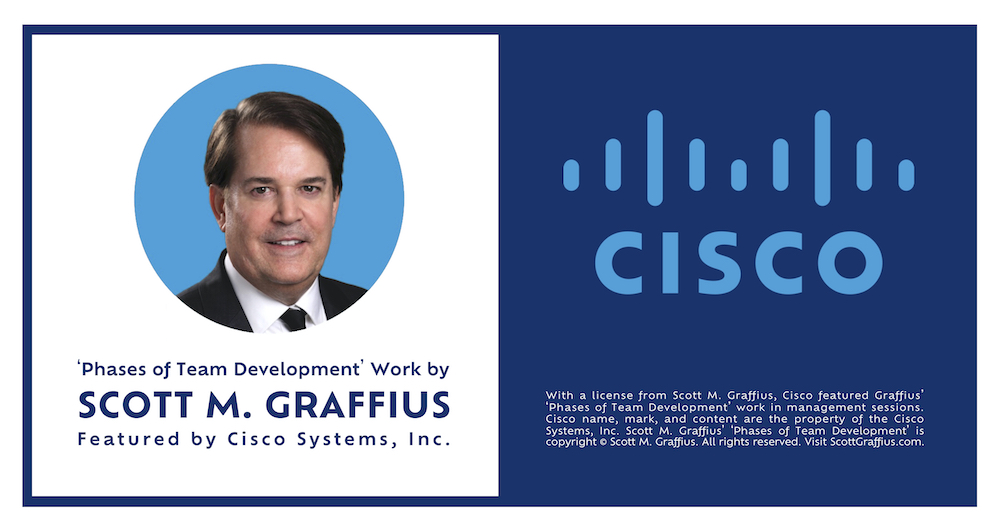










Sign up for Miro—it's free!
(Want more features? You can always upgrade to a paid plan.)


How to Cite This Article
Graffius, Scott M. (2025, March 20). Reporting Errors in 'Frontiers in Public Health': A Case Study. Available at: https://scottgraffius.com/blog/files/reporting-errors-in-frontiers-of-public-health-publication.html. 

Digital Object Identifier (DOI)
DOI: (coming soon)

Content Acknowledgements
This article includes brief excerpts from Frontiers in Public Health ('Public perceptions of digital mental health awareness campaign in the Arab Gulf states: a qualitative thematic analysis' by Noura Alomair, Ghadah Alkhaldi, Norah M. Alsadhan, Rawan Alkasabi, and Samah Alageel), attributed and used under fair use for news reporting and analysis.
Frontiers in Public Health is the property of Frontiers Media S.A.
Graffius’ Lifespan (Half-Life) of Social Media Posts' is copyright © Scott M. Graffius. All rights reserved.

Post-Publication Notes
If there's an update after this article is published, the information will appear here.
Update on 24 March 2025
On 24 March 2025, Frontiers (the publisher) sent an email to Graffius. Here’s an excerpt:
"This is to let you know that the corresponding author has submitted a corrigendum for the article based on your comments. Our editorial team will review the corrigendum."
Update on 24 March 2025
On 24 March 2025, Graffius replied to Frontiers’ email. Here’s an excerpt:
"Please:
1. Inform me know when you’re scheduled to implement the corrections (or an estimated date), and
2. Update me after you’ve implemented the corrections."
Update on 25 March 2025
On 25 March 2025, Frontiers (the publisher) sent an email to Graffius. Here’s an excerpt from it:
"If the corrigendum is accepted, I will send you the link to the online page. There will also be a visible link to the Corrigendum on the original article, as soon as the article is accepted. Once an article is accepted, they are published within 3 weeks on average. Please note that once an article is updated, it can take longer for the update to be reflected in certain repositories, depending on the repository."
Update on 28 March 2025
The most recent update from the publisher was on 25 March 2025. It's noted above.
For context, Graffius reported the errors on 18 December 2024. As of today, that was 100 days ago, and the errors have not yet been resolved. 

Copyright
Copyright © Scott M. Graffius. All rights reserved.
Content on this site—including text, images, videos, and data—may not be used for training or input into any artificial intelligence, machine learning, or automatized learning systems, or published, broadcast, rewritten, or redistributed without the express written permission of Scott M. Graffius.
